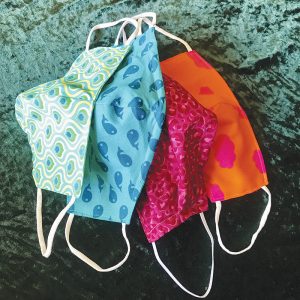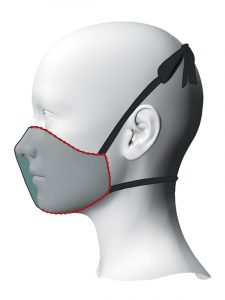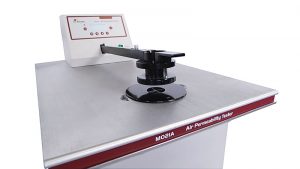
AATCC has introduced a face covering standard — AATCC M14-2020, Guidance and Considerations for General Purpose Textile Face Coverings: Adult — based on the work of an ad-hoc industry group.
By Diana A Wyman
Face coverings are now required or recommended in many areas. Regardless of personal or political opinions, there is a growing demand for these items. To meet this vital need, manufacturers — and consumers — need clear guidance on the function and expected performance of general use face coverings.
Throughout April and May 2020, a group of industry stakeholders met to compile this much-needed guidance. The group included representatives from manufacturing, testing, and research organizations. They drew from their combined knowledge of medical personal protective equipment (PPE), textiles, and regulations as well as face covering standards published for France, China and Belgium, among other countries.
To make the document as widely accessible as possible, the group submitted it for ballot as an AATCC standard. The American Association of Textile Chemists and Colorists (AATCC), Research Triangle Park, N.C., is already well-known for publishing standard test methods, procedures, and monographs for the textile industry. By the end of July, AATCC’s Executive Committee on Research approved the document as AATCC M14-2020, Guidance and Considerations for General Purpose Textile Face Coverings: Adult. The standard is now available as a free download from the AATCC website.
One of the main drivers in developing what became AATCC M14 was practicality. The goal was to deliver something that was easy to understand and provided useful guidance to the myriad of manufacturers who were willing to pivot operations to fill the face covering need, but whose expertise lay elsewhere. Tests and requirements in AATCC M14 were kept as simple and accessible as possible.

dotted red line. (Image courtesy of AATCC)
What’s Covered (No Pun Intended)
The title and scope of AATCC M14 includes some important limitations. The guidance applies only to general use face coverings such as a face covering someone may wear to the grocery store or office, and not to a more specialized mask or respirator prescribed for medical or occupational use. The term face covering is used intentionally to help differentiate general use face coverings from medical face masks. Both terms are clearly defined in the AATCC M14 standard.
The AATCC M14 title also specifies that the guidance is for textile face coverings including woven, knitted and nonwoven constructions. The standard does not address face coverings or face shields made of cast or molded plastic, metal or other non-textile materials.
Finally, AATCC M14 is for adult face coverings. While most of the same recommendations also apply to child face coverings, there are additional regulatory and practical considerations that must be addressed for children’s items.
The AATCC M14 guidance is voluntary — except for the applicable regulations cited — but all face covering manufacturers are strongly encouraged to follow the recommendations for design and testing. Specifiers and regulatory bodies also may require that the face coverings they purchase or approve meet some or all the AATCC M14 guidelines. Even before the standard was officially published, the Atlanta-based Centers for Disease Control and Prevention (CDC) did just that when soliciting strategies to reduce the spread of COVID-19 in a Broad Agency Announcement (BAA 75D301-20-R-68024). In the BAA, the CDC noted that proposals should “consider cloth face covering designs that address some of the features identified in the draft AATCC Guidance and Considerations for General Purpose Textile Face Coverings.”
Regulatory Considerations
Applicable regulations provide manufacturers a clear understanding of what they must do to legally sell a face covering in the United States or Canada. Regulations for other countries are not explicitly enumerated in AATCC M14 because it would require an extremely long list and constant updates; however, the general categories are similar for many countries — flammability, fiber content, care instructions and possibly toxic substance analysis.

Design Considerations
Some sections are less clear-cut. The standard’s authors wanted to provide practical options without restricting design or material selection. To be effective, a face covering must cover the wearer’s nose and mouth with minimal gaps. The dimensions required to achieve a proper fit obviously vary based on the wearer and the type of face covering. AATCC M14 includes resources for average head and face measurements, but allows flexibility for those developing face coverings to fit specific populations or size ranges.
Other sections of the standard take a similar approach. There are examples of fabrics and constructions likely to perform well and examples of those to avoid. For a manufacturer not sure where to start, the suggestions may save valuable time and money that might otherwise be wasted on numerous failed iterations.
While the testing recommendations may be a challenge for small manufacturers, even home sewers can benefit from the material and design considerations included in AATCC M14. Consumers also may consult these sections for help in choosing a face covering for personal use.
Performance Testing
AATCC M14 recommends several tests to evaluate the effectiveness of a face covering. Particle filtration and breathing resistance are the most important properties to be considered. The recommended test methods are ones already in use for other applications so laboratories should be equipped and trained to perform such tests. The methods are the same or similar to tests specified for face coverings to be sold in Europe, simplifying things for multinational manufacturers.
Research
As AATCC M14 was under development, limited quantitative data on the effect of face coverings on the spread of COVID-19 was available. However, research continues and though there is much still to be learned, most current research agrees:
- Airborne transmission is common. People are more likely to contract COVID-19 from inhaling contaminated air than by touching a contaminated surface.3&5
- Asymptomatic and presymptomatic individuals are a significant source of transmission. Multiple studies suggest that more than half of interhuman transmissions is from those who don’t appear sick and may not even know they are infected.1
- Face coverings are an important tool for reducing transmission from infected individuals. A recently published paper concludes that a face covering “corresponds to the most effective means to prevent interhuman transmission” though the authors — and most experts — note that face coverings should be used in conjunction with social distancing and other strategies.5
The CDC emphasizes the role of face coverings in “source control” and research seems to support this idea. The primary function of a general use face covering is to reduce the spread of respiratory droplets from the wearer’s nose and mouth.
Face coverings work because viruses travel on respiratory droplets. These droplets leave the body every time a person breathes, coughs, speaks, sings or sneezes. With no barrier, the virus-containing droplets evaporate to aerosolized particles and can float through the air for more than 12 hours, contaminating surfaces or people they meet along the way.3
Most of what leaves the mouth is relatively large droplets that are easily trapped by a textile face covering. These droplets don’t have a chance to become the longer lasting aerosols or to float away. Even slowing the droplets can have a beneficial effect as they won’t travel as far before falling to the ground. As noted above, individuals may be carrying the virus without even knowing, so a best practice is for everyone to contain his or her droplets just in case!
Of course, some face coverings contain droplets more effectively than others. Several recent studies have looked at different factors, but the variety of test methods employed makes it difficult to compare results or generalize conclusions. Common sense says that a tighter construction with smaller spaces between yarns and fibers is better. But there are other considerations. Hydrophilic fibers and fuzzy fibers with high surface area can also help trap droplets. Triboelectric charging — for example, rubbing a latex glove on a polyester or polypropylene fabric may also help.6 Fit is critical, but this is difficult for a manufacturer to control. Ultimately, consumers must understand the importance of face covering fit and how to achieve the best fit.
It is important to note that most textile face coverings are not designed to filter viruses out of the air a wearer inhales, and the evidence of efficacy for this purpose is less compelling. It is much easier to prevent infected droplets from entering the environment than to filter them out once present.
Because general use face coverings are intended to prevent droplets from entering the atmosphere, they should not include a one-way valve.1 Such valves are used in some respirators to filter incoming air and freely expel air as the wearer breathes out. For general use face coverings, it is the outgoing air that needs to be restricted.
In general, better droplet and/or particle filtration means higher breathing resistance — which means it is more difficult to breathe — but very few studies found any textile material that significantly restricted breathing, even with numerous layers. Greater surface area, with the same breath volume, means less pressure. It will be easier to breathe through the face covering and wearers won’t be as likely to inadvertently create gaps at the sides of the face covering.1
In June 2020, the World Health Organization (WHO) updated its recommendations regarding use of face coverings.4 Although WHO is still noncommittal about the use of face coverings for the general public, it does offer some very specific advice for construction of non-medical face coverings. Materials should provide good filtration efficiency and breathability, properties also addressed by AATCC M14. WHO and AATCC M14 both recommend avoiding coatings that can interfere with breathing and ensuring a close fit at the edges to avoid leakage. WHO requires a minimum of three layers while AATCC M14 suggests two to three layers. As noted above, general use face coverings are intended to contain respiratory droplets, so both WHO and AATCC M14 highlight the importance of selecting inner and middle layers that absorb and/or hold these droplets. WHO guidance suggests an outermost layer made of hydrophobic material “which may limit external contamination from penetration through to the wearer’s nose and mouth.” Aside from research showing minimal effectiveness of most textiles for this type of filtration, there is evidence that the virus survives longer on hydrophobic materials.2 This means wearers must be especially careful about touching the outside of such face coverings while wearing or removing them.
As new research is performed and published, there will undoubtedly be more precise recommendations regarding the best materials and design for face coverings. Hopefully, there will also be simpler, quicker, or more accurate ways to evaluate face covering performance.
Next Steps
While the first version of AATCC M14 was developed by an ad-hoc industry group, future revisions and related standards will be developed by AATCC committee RA113 Emerging Technologies Test Methods. As with all AATCC committees, participation is open to all interested parties.
“The first task the committee will be working on is to develop a guideline for children’s face coverings that provides considerations in regulatory compliance, material selection, performance standards and evaluation methods, design and care instructions, and any other related aspects,” said Committee Chair Min Zhu, SGS North America. The committee is currently focusing on face coverings but will evolve as new industry demands arise. “The specific scope of work will change as new issues emerge due to the increasing uncertainty of the market,” Zhu explained. “The committee is aiming at developing new test methods or providing industry guidance in a timely manner to help textile industry stakeholders respond to ever-changing challenges with more resources.”
Related Efforts
In addition to the new AATCC M14 standard, AATCC provides several test methods and materials in high demand for medical PPE testing. The standards are currently available at no cost.
In July, ASTM International subcommittee F23.65 on Respiratory opened a new work item (WK73471) to develop a new specification for barrier face coverings. F23.65 is part of committee F23 on Personal Protective Clothing and Equipment. The title and scope of the specification is still under discussion, but the intent is to define minimum requirements allowing manufacturers to certify that a product “Meets ASTM FXXXX.” The basic criteria of fit, filtration, and breathing resistance are similar to those cited in AATCC M14, though different test methods are used, including a new leakage factor test currently being developed by the same ASTM subcommittee.
There are several other general use face covering standards currently in use around the world. AFNOR SPEC S76 was one of the first to be published in March 2020. This French standard includes sample patterns and construction procedures. It also includes wearer instructions for use and care of face coverings. AFNOR SPEC S76 forms the basis of several other documents, including the European guide CWA 17553. China, Korea, and other countries have also published national standards or guides. As of August 2020, there are no required criteria for general use face coverings in the United States. Manufacturers should refer to voluntary industry guidelines such as AATCC M14, along with current research and the latest advice from relevant government agencies.
References:
1 Kahler, C. J., & Hain, R. (2020, May). Fundamental protective mechanisms of face masks against droplet infections. Journal of Aerosol Science. Retrieved from https://www.researchgate.net/publication/342693523_Fundamental_protective_mechanisms_of_face_masks_against_droplet_infections
2 Lai, M. Y., Cheng, P. K., & Lim, W. W. (2005, October). Survival of severe acute respiratory syndrome coronavirus. Clinical Infectious Diseases, pp. e67-e71. Retrieved from https://pubmed.ncbi.nlm.nih.gov/16142653/
3 Prather, K. A., Wang, C. C., & Schooley, R. T. (2020, June 26). Reducing transmission of SARS-CoV-2. Science, pp. 1422-1424. Retrieved from https://science.sciencemag.org/content/sci/368/6498/1422.full.pdf
4 World Health Organization. (2020, June 5). Advice on the use of masks in the context of COVID-19: Interim guidance. World Health Organization. Retrieved from World Health Organization: https://apps.who.int/iris/rest/bitstreams/1279750/retrieve
5 Zhang, R., Li, Y., Zhang, A. L., Wang, Y., & Molina, M. (2020, June 30). Identifying airborne transmission as the dominant route for the spread of COVID-19. PNAS, pp. 14857-14863. Retrieved from https://www.pnas.org/content/117/26/14857
6 Zhao, M., Liao, L., Xiao, W., Yu, X., Wang, H., Wang, Q., . . . Cui, Y. (2020, June 2). Household Materials Selection for Homemade Cloth Face Coverings and Their Filtration Efficiency Enhancement with Triboelectric Charging. Nano Letters, pp. 5544-5552. Retrieved from https://pubs.acs.org/doi/10.1021/acs.nanolett.0c02211
A more extensive bibliography is available at www.aatcc.org/covid.
Editor’s Notes: Diana Wyman is executive vice president of the Research Triangle Park, N.C.-based American Association of Textile Chemists and Colorists (AATCC). Individuals interested in AATCC committee RA113 Emerging Technologies Test Methods can find out more or submit an application at aatcc.org/testing/committees. Additional information, updates, and resources related to COVID-19 are posted at aatcc.org/covid.
September/October 2020




